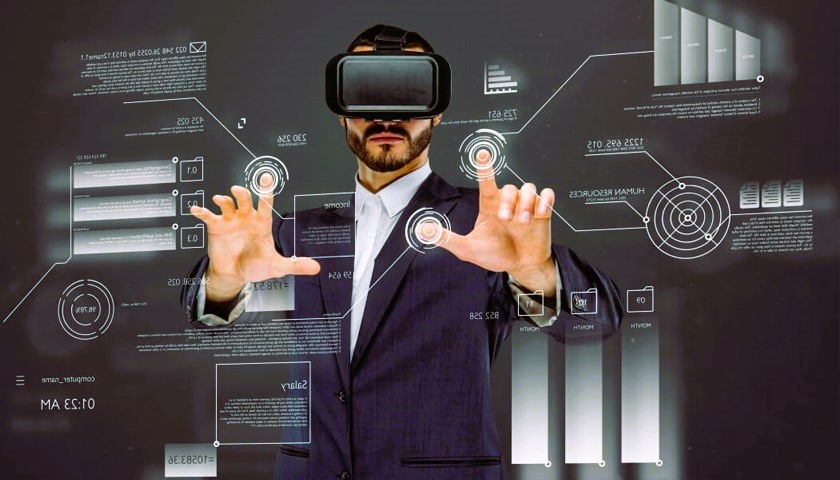The landscape of business is continually evolving, and technological advancements play a pivotal role in driving this change. Among the myriad of emerging technologies, Augmented Reality (AR) and Virtual Reality (VR) stand out as transformative tools with the potential to revolutionize various aspects of business operations. This article explores the applications, benefits, and challenges of AR and VR in the business realm, shedding light on how these immersive technologies are reshaping the way companies operate and engage with their stakeholders.
Understanding Augmented Reality and Virtual Reality
1. Augmented Reality (AR):
AR involves overlaying digital information or virtual elements onto the real-world environment. This is typically achieved through devices like smartphones, tablets, or AR glasses. AR enhances the user’s perception of the physical world by superimposing digital content, such as graphics, text, or 3D models.
2. Virtual Reality (VR):
VR, on the other hand, immerses users in a completely virtual environment, shutting out the physical world. This is usually accomplished using VR headsets or goggles, providing users with an immersive and interactive experience. VR environments can simulate real-world scenarios or create entirely fictional settings.
Applications of AR and VR in Business

1. Training and Development:
AR and VR are revolutionizing training programs by providing immersive and interactive simulations. Employees can undergo realistic training scenarios, such as equipment operation or emergency response, without real-world consequences. This is particularly valuable in industries like manufacturing, healthcare, and aviation.
2. Product Design and Prototyping:
In product development, AR and VR enable teams to visualize and interact with 3D models at various stages. This enhances the design process, allowing for better collaboration, iteration, and understanding of how products will function in the real world. Enabling people to protect their digital rights, read more in the article on Digital Literacy.
3. Remote Collaboration:
With the rise of remote work, AR and VR facilitate virtual collaboration by creating shared digital workspaces. Team members located in different geographical locations can meet in virtual environments, fostering better communication and collaboration.
4. Customer Engagement:
AR and VR are transforming customer interactions by providing immersive experiences. Retailers, for example, use AR applications to allow customers to virtually try on clothing or visualize furniture in their homes. VR is employed in creating virtual showrooms or providing virtual tours of properties in real estate.
5. Marketing and Advertising:
Both AR and VR offer innovative ways for businesses to engage with their audience. AR can be used to create interactive and engaging marketing campaigns, while VR enables businesses to transport consumers to immersive brand experiences through virtual events or demonstrations.
6. Data Visualization:
AR and VR enhance data visualization by translating complex data sets into interactive and easily understandable visual representations. This is particularly beneficial in industries like finance, where complex financial data can be presented in a more intuitive and immersive manner.
7. Health and Safety Training:
In high-risk industries such as construction or manufacturing, AR and VR are employed for health and safety training. Workers can undergo realistic simulations of hazardous scenarios, improving their preparedness and reducing the risk of accidents.
Benefits of AR and VR in Business
1. Enhanced Training Efficiency:
AR and VR-based training programs enhance efficiency by providing hands-on experience in a risk-free environment. This accelerates the learning curve and improves retention compared to traditional training methods.
2. Improved Collaboration:
Remote collaboration is made more effective with AR and VR, fostering better communication among team members. Virtual meetings and collaborative workspaces enable real-time interaction, reducing the limitations imposed by physical distances.
3. Innovative Marketing Strategies:
Businesses can differentiate themselves through innovative marketing strategies powered by AR and VR. Immersive and interactive experiences capture the attention of consumers, creating memorable brand interactions.
4. Cost Savings in Prototyping:
AR and VR streamline the prototyping process by allowing designers to visualize and iterate on 3D models virtually. This reduces the need for physical prototypes, saving both time and resources.
5. Enhanced Customer Engagement:
AR and VR enhance customer engagement by providing personalized and interactive experiences. Whether through AR applications in retail or VR-based virtual tours, businesses can create a more compelling connection with their audience.
Challenges of AR and VR in Business

1. Cost of Implementation:
The initial cost of implementing AR and VR technologies, including hardware and software, can be significant. This cost factor may pose a barrier, especially for small and medium-sized enterprises (SMEs).
2. Integration with Existing Systems:
Integrating AR and VR technologies with existing business systems and workflows can be complex. Ensuring seamless integration without disrupting ongoing operations is a challenge that businesses must navigate.
3. Technical Limitations:
The current technical limitations of AR and VR hardware, such as limited field of view and resolution, can impact the overall user experience. Advancements in hardware are needed to address these limitations.
4. Data Security and Privacy:
The collection and utilization of data in AR and VR applications raise concerns about data security and privacy. Businesses must implement robust measures to protect sensitive information and ensure compliance with data protection regulations.
5. User Adoption and Training:
The successful implementation of AR and VR technologies requires user adoption. Employees and customers may need training to become familiar with these technologies, and resistance to change could pose challenges.
Standards in AR and VR
For those interested in exploring standards and best practices in the field of AR and VR, the Wikipedia page on Augmented Reality and Virtual Reality provide comprehensive insights. These resources cover various aspects, including definitions, technologies, and applications, offering valuable perspectives on the standards that shape the AR and VR landscape.
The Future of AR and VR in Business
As technology continues to advance, the future of AR and VR in business holds exciting possibilities. Improved hardware, increased affordability, and further integration with artificial intelligence (AI) are expected to propel these immersive technologies into mainstream business operations.
Conclusion
Augmented Reality and Virtual Reality are no longer futuristic concepts but integral components of the contemporary business landscape. The applications of AR and VR extend across diverse industries, offering innovative solutions to age-old challenges. While businesses reap the benefits of enhanced training, improved collaboration, and innovative marketing, they must also navigate challenges related to cost, technical limitations, and data security. By staying informed about emerging standards and best practices, businesses can harness the full potential of AR and VR, propelling themselves into a future where immersive technologies redefine the way we work, collaborate, and engage with the world.
